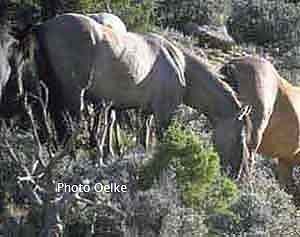WHAT ABOUT mtDNA?
What’s the big deal about mitochondrial DNA? Is it similar to the blood marker typing I’ve heard of? And is it true that it tells only half the story because it’s passed on only through the female line?
No, it is totally different from bloodmarker analysis, and much more advanced. The bloodmarker analysis is simply the wrong tool when it comes to the determination of relatednesses of populations and breeds. It is actually an outdated method every way one looks at it.
There is nuclear DNA and mitochondrial DNA (mtDNA). The mitochondrial DNA is found outside of the nuclear DNA, it is irrelevant for an animal's genetic makeup, but excellent for phylogenetic studies. In contrast to nuclear DNA – and this is very important – mitochondrial DNA cannot be altered through selective breeding.
Pryor Mountain mustang mare of Sorraia type
Mitochondrial DNA sequencing can do two things:
1. It is the only reliable method to determine relatednesses between breeds and/or populations, and relatednesses of individuals to populations. In the latter case, bloodtyping would fail completely.
2. It is the instrument to determine phylogenetic facts, i.e. ancestral relationships. For instance: Japanese geneticists had established through mtDNA sequencing that the Mongolian wild horse (a.k.a. Przewalski’s horse) is not an ancestor of our domestic breeds. This was later confirmed by the work of Jansen et al.*).
While it is correct that mtDNA is passed on only through the maternal line, the presence of a certain mtDNA pattern in an animal proves beyond doubt that, at least through the maternal line, this animal is indeed related to the population for which this pattern is typical. Through mtDNA sequencing done by the Institute for Molecularbiological Diagnosis (now Certagen) in Germany, a relatedness of Sorraias and certain mustangs was scientifically proven; the same holds true for a relatedness of certain mustangs and Andalusians and Lusitanos. This means that there are indeed mustangs which trace back at least in their maternal line to the Sorraia population, and that many go back to the ancestors of the Andalusian and the Lusitano. It stands to reason that if this is the case, many will in fact also go back in their paternal lines to the Sorraia and other respective ancestors, even though we can’t prove it (yet).
*) Jansen, Forster, Levine, Oelke, Hurles, Weber, Olek, "Mitochondrial DNA and the origins of the domestic horse", 2002, Proceedings of the National Academy of Sciences

